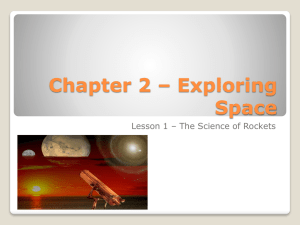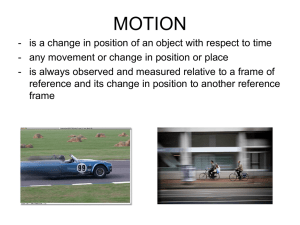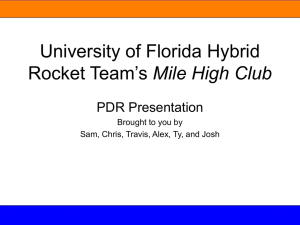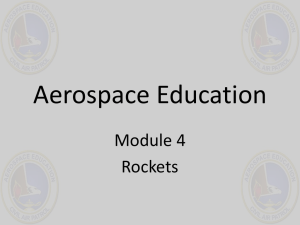Lesson 2 - 308 (Colchester) ATC
advertisement
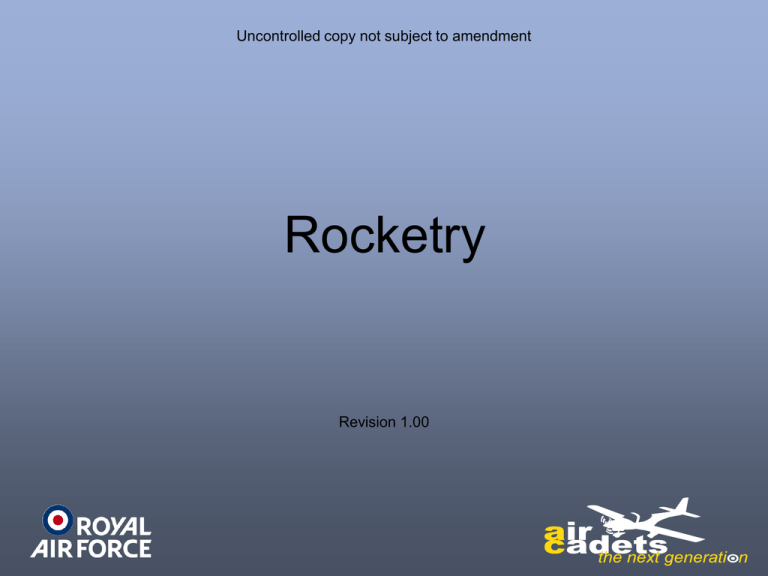
Uncontrolled copy not subject to amendment Rocketry Revision 1.00 Chapter 2 Applications of Rockets Applications of Rockets • Rockets are vehicles, and like all vehicles they exist to move things, for example: – Move a scientific instrument from the ground into the upper atmosphere – Take astronauts to space (and back) – Fire a rescue line between two ships – Place a weapon onto a target – Eject a pilot from a damaged aircraft Applications of Rockets • An object carried by a rocket for peaceful purposes is called the payload • An object carried for military purposes is called a warhead Uses of rockets • • • • • • • • • Military rockets and missiles Rocket cars Rocket Planes Flares Space flight Rescue Entertainment Hobby and amateur rockets Transportation Military Rockets and Missiles • Military rockets are unguided weapons – they have no ability to steer themselves towards a target – Suitable for static or slow moving targets Military Rockets and Missiles • Missiles are guided weapons – they have the ability to change direction – they follow instructions to help them to hit the target – Radar, TV, heat sensors are used to locate and home onto targets Military Rockets and Missiles • The German V2 was the first rocket to be used as a long range weapon • It carried a 1 ton warhead for up to 200 miles • Rocket motor accelerated the V2 to 3000 mph • It coasted to 55 miles altitude • The V2 fell ballistically onto its target Active Homing • In an active homing system the missile uses its own radar transmitter and receiver to find and track the target, sending commands to the flight system to steer the missile towards the target. • A missile with active homing can steer itself onto the target without external assistance Passive Homing • In a passive homing system the missile does not transmit, but looks for a signal to indicate where the target is. • This could be a radio or heat signal from the target itself, radar reflections from another radar, or target illumination. Military Rockets and Missiles • Surface to Air Missile (SAM). Launched from the ground or ships to attack aircraft. • Air to Surface Missile (ASM). Launched from aircraft to attack targets on the ground. • Surface to Surface Missile (SSM). Launched from the ground to attack targets on the ground. • Air to Air Missile (AAM). Launched from aircraft to attack other aircraft. Military Rockets and Missiles • Anti Tank Missile. Launched from the surface with a warhead specifically designed to penetrate the armour of tanks. • Anti Shipping Missile. launched from the surface, ships or aircraft to attack ships. • Ballistic Missile. Launched from the surface to carry nuclear or conventional warheads to surface targets. ballistic missiles capable of travelling great distances are called Intercontinental Ballistic Missiles (ICBM) Military Rockets and Missiles • Anti Shipping Missile. launched from the surface, ships or aircraft to attack ships. • Ballistic Missile. Launched from the surface to carry nuclear or conventional warheads to surface targets. ballistic missiles capable of travelling great distances are called Intercontinental Ballistic Missiles (ICBM) • Anti Ballistic Missile. Surface launched missiles designed to destroy incoming ballistic missiles. Rocket Cars • The first recorded rocket car was the RAK-1 made by Fritz Opel in 1928 as a publicity stunt. The car achieved a top speed of 47 mph. • The fastest rocket car was the Blue Flame which achieved a speed of 622.407 mph at the Bonneville Salt Flats on 23 Oct 1970. Rocket Sleds • Rocket sleds are similar to rocket trains as they both run along a track. • They’re used for testing: – experimental equipment on the ground – ejector seats – rocket systems – munitions • The fastest recorded speed by a rocket sled is 6416 mph Rocket Planes • Rocket planes offer very high speed but are much less efficient than jet aircraft. • The Messerschmitt ME 163 is the only mass produced rocket plane • It was designed to be a rocket powered fighter aircraft. • It saw service in 1944. Rocket Planes • The X-15 was the first aircraft to fly into space • Only three X-15 aircraft were made, and one was lost in a crash • It was used as a test vehicle for many of the ideas which were incorporated into manned spacecraft Rocket Planes • Rocket planes are used at experimental test vehicles. • The US Government has built a succession of experimental rocket powered aircraft called the “X Planes” • The first aircraft to break the sound barrier was the rocket propelled Bell X-1, piloted by Chuck Yeager • Note the Mach diamonds in the picture Flares • Rocket powered flares have may uses: – A red flare launched from a ship or small boat is an internationally recognised distress signal – Trip flares are used by the military to provide early warning of enemy approaches • The flare is boosted by a rocket motor and desc ends slowly by parachute Rocket Planes • “Spaceship One” was the first privately made rocket plane to fly to space. • “Spaceship Two”, a larger version of Spaceship One, is designed to offer space tourists for Virgin Galactic • “Skylon” is being designed in the UK to offer space flight from conventional runways. Escape Systems • Ejector seats are installed in many in military aircraft to rapidly remove the pilot from danger. • Once fired, the seat’s operation is automatic, giving an unconscious or injured pilot a good chance of survival Escape • It is impractical to install individual ejector seats into space capsules, so an alternative system is used for manned space missions. • To prevent setting fire to the capsule the escape system has 3 nozzles so the hot exhaust plume is deflected around the side of the capsule Spaceflight • Space begins at the Karman Line at an altitude of 100 km (62.1 miles) above sea level. • At this altitude there is no useable atmosphere so: – Air breathing propulsion such as jets and internal combustion engines will not work – Aircraft have no atmosphere to develop lift from their wings – Balloons have no atmosphere to provide buoyancy • The only type of propulsion that will get objects into space is a rocket motor. Spaceflight • Rockets have been used for every type of space mission: – launching satellites – manned space flight – sending probes to other planets – exploration of the upper atmosphere • Rockets that are used to propel objects to orbits outside the atmosphere are called launch vehicles. Rocket Belts • Rocket belts are a type of personal flying machine. • The limitation of rocket belts is that the pilot can only carry a small amount of propellant, typically enough for only 10 to 30 seconds flight • Rocket belts have found a practical use in the weightlessness of space. NASA’s Man Manouvering Unit (MMU) is a practical rocket belt that has seen extensive use on space shuttle missions.





